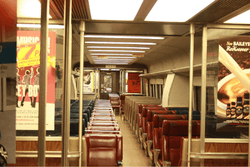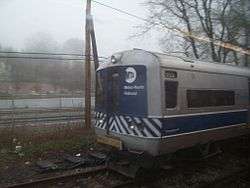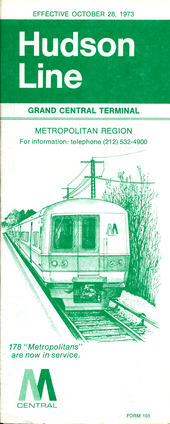M1/M3 (railcar)
| M1/M3 | |
|---|---|
 An M1 on the Long Island Rail Road at Jamaica
in 2005. | |
 The interior of an LIRR M3. | |
| In service |
M3: 1985-present M3A: 1984-present |
| Manufacturer | Budd Company |
| Built at |
Red Lion Assembly Plant Northeast Philadelphia, PA |
| Family name | Budd Metropolitan |
| Constructed |
M1/M1A: 1968-1973 M3/M3A: 1984-1986 |
| Entered service |
M1: 1968 M1A: 1971 M3: 1985 M3A: 1984 |
| Scrapped |
M1: 2007 M1A: 2009 |
| Number built |
1264
|
| Number in service |
M1: (2 in work service) M3: 148 (additional 4 in work service) M3A: 142 |
| Number preserved | 2 (M1 only) |
| Number scrapped |
962
|
| Formation | Married Pair |
| Fleet numbers |
M1: 9001-9770 M1A: 8200-8377 M3: 9771-9944 M3A: 8000-8141 |
| Capacity | 120 (M3)[1] |
| Operator(s) |
Long Island Rail Road Penn Central Conrail Metro-North Railroad |
| Specifications | |
| Car body construction | Stainless Steel, with fiberglass end caps on the operating ends |
| Train length | 170 ft (51.82 m) - 1,020 ft (310.90 m) |
| Car length | 85 ft (25.91 m) |
| Width | 10 ft 6 in (3,200 mm) |
| Height | 13 ft (3,962 mm) excluding rooftop horns |
| Floor height | 4 ft (1,219 mm) |
| Platform height | 4 ft (1,219 mm) |
| Doors | Quarter point, double leaf automatic |
| Maximum speed |
100 mph (160 km/h) design 80 mph (130 km/h) service |
| Traction system | DC current fed through a camshaft controlled resistance switch to 4 DC traction motors. |
| Traction motors |
M1/M1A: 4x148 horsepower (110 kW) GE 1255 A2 M3/M3A: 4x160 horsepower (120 kW) GE 1261(M3) |
| Power output |
M1/M1A: 592 horsepower (441 kW) M3/M3A: 640 horsepower (480 kW) |
| Transmission | Electric |
| Train heating | electric heat, air conditioning |
| Electric system(s) | 650 V DC - 750 V DC Third Rail |
| Current collection method | Contact shoe |
| Bogies |
M1: Budd Pioneer M3: General Steel GSI 70 |
| Braking system(s) | Pneumatic, dynamic |
| Safety system(s) | Cab signals with Automatic Train Control. emergency brakes |
| Coupling system | WABCO Model N-2 |
| Headlight type | Halogen light bulbs |
| Track gauge | 4 ft 8 1⁄2 in (1,435 mm) standard gauge |
The M1 and M3 are two similar series of electric multiple unit rail cars built by the Budd Company for the Long Island Rail Road, the Metro-North Railroad and Metro-North's predecessors, Penn Central and Conrail.[2] Originally branded by Budd as Metropolitans, the cars are more popularly known under their model names, M1 (late 1960s/early 1970s cars) and M3 (mid 1980s cars). The Metro North cars were branded under the M1A and M3A series.
Overview

Even though the LIRR's fleet of some 900 MP54 electric MU cars constructed between 1908 and 1930 had been augmented between 1955-1963 by about 150 newer MP72 and MP75 EMUs, the roster still contained a large number of increasingly elderly prewar cars which the cash strapped LIRR was unable to replace. In 1965 the nearly bankrupt commuter railroad was taken over by the state owned Metropolitan Commuter Transportation Authority, later renamed the Metropolitan Transportation Authority in 1968, which was then able to provide large amounts of capital funding to bring the system to a state of good repair. One of the first items on the list was a massive order of brand new self-propelled electric railcars that could replace the remaining MP54s and provide modern levels of comfort and performance.
The Metropolitans, at the time of their introduction, were notable for their rounded ends and quarter-point sliding doors. The cars were fully air conditioned, accommodated only high level boarding, used light weight construction and were built with a top speed of 100 mph[3] and support for Automatic Train Operation. The Metropolitan cars were also the catalyst of change for their respective systems as the high-level boarding required all stations in the electrified zone to be rebuilt from 1966-1968[4] and the increased power demand forced the LIRR to update its third rail power supply from 650 V DC to 750 V DC to take advantage of the cars' performance. On December 30, 1968 the M1s went into revenue service, with the first revenue train being an 8-car local from Babylon to Penn Station.
With a completely new look and feel both inside and out the Metropolitan cars blurred the line between traditional commuter rail and rapid transit with the later R44 and R46 series of cars for the sister New York City Subway adopting many of the same design elements. Compared to the older cars with their drop sash windows, slow speeds, rough suspension and growling gearboxes the Metropolitans ushered in a new era of commuting in the New York region.
M1/M1A series

The M1 series were funded by both New York State and the then-fledgling Metropolitan Transportation Authority which gained operation of the lines partway though the order.[2] The 770 M1s (9001-9770) built for the LIRR between 1968 and 1973 represented the largest single order of electric multiple units in North America up until that time. 620 cars were in the base order from 1968–71, with 150 option cars following in 1973. An Additional 178 M1As (8200-8377) were built for the former New York Central commuter operations from 1971 and 1973 allowing the railroad to replace its remaining pre-war MU cars and the 100 4500 series ACMUs which were in need of a 20-year overhaul. Using Budd Pioneer III trucks and powered by 4 148 horsepower (110 kW) GE 1255 A2 traction motor, each car had 592 hp and were designed to achieve 100 mph running in service, achieving only 80 mph in service due to track and signaling limitations. The LIRR cars also featured support for Automatic Train Operation, although this too was never seen in service.
The Cosmopolitans
On the heels of the success of the M1/M1As, the MTA and a joint venture between GE, Budd, Canadian Vickers and Avco produced a series of structurally similar cars for the New Haven Line. Built between 1972 and 1977, the M2s (initially branded by Budd as the Cosmopolitans) fully replaced the ex-New Haven EMU cars for use on the New Haven mainline and the New Canaan Branch. Budd and MTA would later license the design to other manufacturers for updated versions.
GTELs
In the late 1970s, eight "GTEL" (Gas Turbine-ELectric) trains were built; four were built by Garrett AiResearch and four by General Electric. These cars were numbered 4001-4008, and were powered by both a gas turbine engine and third rail collection for a dual mode operation. They were tested by the LIRR to see the feasibility of running such cars on non-electrified branches. They used the M1 bodies, but had low level boarding stairs. After around 1977, the cars were out of service. The Garrett-built cars were ultimately scrapped, while the General Electric-built cars became M1As for Metro-North.
M3/M3A series

With electrification areas of both railroads expanding, the MTA placed an order for another series in 1982, the M3 series. Essentially compatible with, and (on the exterior) very similar to, the M1 series, the M3s had updated mechanical elements such as the use of General Steel GSI 70 trucks and a few other small differences. Traction motor cooling was added to the M3 at the cost of added weight which was compensated for by the use of more powerful 160 horsepower (120 kW) GE 1261 motors. Even with the extra power this created different acceleration and braking rates from the M1. While LIRR chose to mix M1s and M3s in the same consist, Metro-North chose not to and would always run with uniform trainsets. 174 M3s (9771-9944, with 9891 and 9892 renumbered to 9945 and 9946 after the Long Island Rail Road massacre) were produced for the LIRR between 1984 and 1986 with 142 M3As (8000-8141) produced for Metro North, arriving between 1984 and early 1985.
This order would be the second-to-last handled by Budd, which in April 1987 left the railroad business after taking the name "TransitAmerica" under which the last M3s were produced though their builders plates kept the Budd name.
Refurbishment
With the arrival of the M3 series, the M1 and M1A cars each saw midlife rebuilds in the late 1980s in order to prolong their useful life. The overhauled interiors were very similar to those of the M3s. Still, time began to take its toll on the original M1 cars and by the end of the 20th century the time for the cars was running short.
Some Metro-North M3As received minor interior refreshes throughout 2006/2007. The LIRR M3s, however, have remained with their original, old-fashioned interior style of wood-and-leather.
Retirement

M1
In 1999, the MTA awarded Bombardier Transportation the contract to build the replacement for the M1 series, the M7 series. With the arrival of the first M7s to the LIRR in 2002 and the first M7As to Metro North in 2004, both roads began to retire the M1 series. LIRR retired the last M1 cars in January 2007, while a small number of M1As remained in service on Metro-North until March 2009. In preparation of the retirement of the M1s, the Sunrise Trail chapter of the National Railway Historical Society hosted a "Farewell to the M1s" fan trip on November 4, 2006.
The Railroad Museum of Long Island in Riverhead, NY has preserved M1 pair 9547-9548. Pair 9411-9412 survive as training cars at the Nassau County Fire Service Academy in Bethpage. Cars 9401 and 9591 were renumbered to E401 and E591 (respectively) and serve as rail adhesion cars. Pair 9745-9746 was held for preservation by the New York Transit Museum and was stored around the system until May 2018, when it was taken off property for scrapping.[5]
M3
In the 1990s, M3 car 9776 was wrecked in an accident and subsequently scrapped. Its mate, 9775, was converted to a rail adhesion car and renumbered to E775. On January 22, 2013, car 9870 was retired when it collided with a car at Brentwood station and then caught fire. It is currently stored out of service.[6][7] Its mate, 9869, was mated with 9772, which lost its mate 9771 due to electrical failures on that car.
Between 2011 and 2013, twenty M3 cars were prematurely taken out of service and stripped of parts to keep the other cars running. They were taken off property to be scrapped in 2018.
In 2018, M3 pair 9901-9902 was converted to a pair of rail adhesion cars. The cars were renumbered to E901-E902.
As of 2013, the MTA has spent nearly $2 billion to procure a replacement for the M3 series, the M9, which is similar to the M7 and are expected to enter service sometime this year in 2018.[8][9] January 2012 forecasts place total M9 procurement at 462 cars, with 252 going to the LIRR and 210 going to Metro-North.[10]
See also
Notes
- ↑ "Supplementary Information for §1269(d) 2012 – 2017" (PDF). mta.info. Metropolitan Transportation Authority. 2012. Retrieved July 24, 2016.
- 1 2 Cudahy, p. 264
- ↑ Middleton, p. 271
- ↑ Cudahy, p. 212
- ↑ https://www.facebook.com/OBRRM/posts/10154556021942331
- ↑ http://pix11.com/2013/01/22/lirr-train-collides-with-vehicle-near-brentwood-train-station/
- ↑ http://www.nbcnewyork.com/news/local/Long-Island-Rail-Road-LIRR-Train-Crashes-into-Car-Suffolk-Avenue-Crossing-2-Killed-Brentwood-187903021.html
- ↑ "MTA Capital Amendment, Page 11/12" (PDF). Archived from the original (PDF) on 2008-08-07.
- ↑ "MTA 2008-2013 Capital Plan, Page 68" (PDF).
- ↑ http://www.nxtbook.com/nxtbooks/sb/ra0112/#/52
References
- Cudahy, Brian J. (2003). A Century of Subways: Celebrating 100 Years of New York's Underground Railways. New York: Fordham University Press. ISBN 0-8232-2292-6.
- Middleton, William D. (2001) [1974]. When the Steam Railroads Electrified (2nd ed.). Bloomington, Indiana: Indiana University Press. ISBN 978-0-253-33979-9.
External links
![]()
